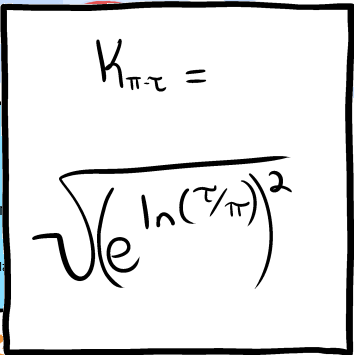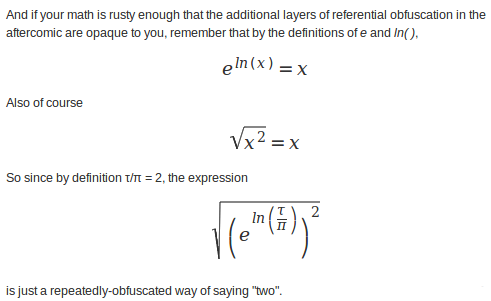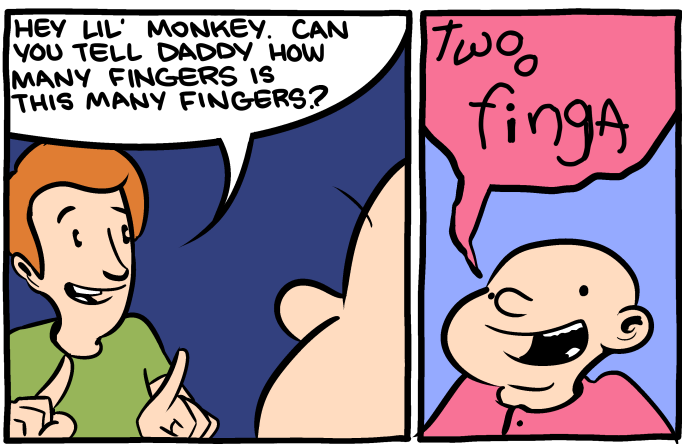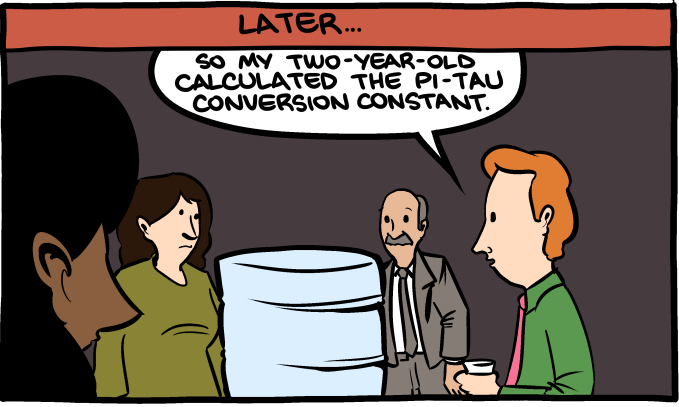Parental opacity
« previous post | next post »
The most recent SMBC gives a neat illustration of some issues in the philosophy of language. Here's the set-up:
And the punch line:
Also, the aftercomic:

If you're not up to speed on the whole pi-tau thing, read Michael Hartl's "The Tau Manifesto", catch up with tau news at the State of the Tau, or watch this animation by Lucas Barbosa, which explains why 360 degrees (or the circumference of a unit circle) is τ radians (rather than 2π radians…):

For a lucid discussion of the philosophical issues involved in the comic's watercooler conversation, see e.g. Barbara Abbott, "Attributive, Referential, De Dicto and De Re".
And if your math is rusty enough that the additional layers of referential obfuscation in the aftercomic are opaque to you, remember that by the definitions of e and ln( ),
Also of course
So since by definition τ/π = 2, the expression
is just a ris just a repeatedly-obfuscated way of saying "two".
For some reason, the creative use of referential methods in parental boasting doesn't seem to have gotten the philosophical attention that it deserves.
[Note that you will need something like MathJax in order to see the MathML equations rendered above. I've attempted to introduce the relevant JavaScript on the Language Log side, but in case this doesn't work for you, you can see the equations properly rendered in this screenshot:

]


TonyK said,
October 5, 2013 @ 10:07 am
You render bad, man! This is what your three equations look like to me:
e lnx = x
x2 = x
e lnt = p2
(where that t should be a tau, and that p should be a pi). If I weren't a mathematician, I would be baffled.
[(myl) You need a browser that understands MathML. (Or I need to install code in our WordPress installation to render MathML properly…) The underlying HTML is like here, and the result (in Chrome on Linux with MathJax installed) is:
]
Ernie in Berkeley said,
October 5, 2013 @ 11:36 am
You also might enjoy Vi Hart's take on tau:
http://www.youtube.com/watch?v=jG7vhMMXagQ
dainichi said,
October 5, 2013 @ 11:49 am
Maybe I'm stating the obvious here, but the de re reading isn't quite possible here, is it? I mean, you can't really "calculate 2", can you? I would take "calculate" here to mean something like "reduce (to some standard format)", but 2 can't really be reduced further, at least not using any common standard format.
[(myl) Good point. But the baby did count to two based on a display of two fingers, which is a form of calcuation. So it would be fair for the dad to have said "My two-year-old calculated the cardinality of a set consisting of one finger on each of my hands". And the referent of the definite description "the cardinality of a set consisting of one finger on each of my hands" is two, as is the referent of the "the pi-tau conversion constant". Right?]
Ralph Hickok said,
October 5, 2013 @ 2:53 pm
To calculate, one must count pebbles, not fingers. Any language purist can tell you that.
[(myl) You win the thread, no question about it.]
John Roth said,
October 5, 2013 @ 9:00 pm
Renders fine in the current version of Firefox.
And while I'm completely in favor of replacing 2 pi by tau, I seriously doubt that it's going to happen.
D.O. said,
October 6, 2013 @ 12:09 am
Wikipedia informs us that π (what a ghastly font) as a symbol for 4arctan(1) has been introduced in mid-18th century, which probably excludes Archimedes as a perpetrator (it blames basically Euler for the widespread adoption). Also that τ was originally meant to be π/2, which kind of makes sense because ττ looks pretty similar to π if the white space in between is removed. The better choice for 2π would be to adopt κ as the first letter of the Greek word for circle.
As a demonstration of de re/de dicto distinction the comic is kind of a failure. After all, "two finga" is not the same thing as "two". Of course, if the junior answered precisely the question he was asked… On the other hand, the dad failed to bend his fingers somewhat, which would make for a nicer joke.
Jason said,
October 6, 2013 @ 5:56 am
@D.O. As a demonstration of de re/de dicto distinction the comic is kind of a failure. After all, "two finga" is not the same thing as "two".
Yeah, I was trying to figure out whether the baby was supposed to be interpreted as saying something like "2 (th)ine R". Comic makes no sense. Must have been on deadline.
Keith M Ellis said,
October 6, 2013 @ 9:36 am
For users of Chrome, there is the extension MathJax for Chrome which will render using MathJax universally, including those here.
Annie Pearson said,
October 6, 2013 @ 12:07 pm
Except the real problem, at which the kid failed, was disambiguation of a rather complex grammar structure, for which the correct answer is either Yes or No.
Matt said,
October 6, 2013 @ 8:06 pm
Except the real problem, at which the kid failed, was disambiguation of a rather complex grammar structure, for which the correct answer is either Yes or No.
Furthermore, even granting the extremely dubious premise that the baby's interlocutor sought information rather than information, the number of figures indicated was clearly either eight (since all fingers were visible, as well as two non-finger thumbs) or zero (if we hypothesize that the pointing gesture was intended to indicate the referent of "this", the specifics of which may be argued but which clearly cannot include any fingers).
Faldone said,
October 10, 2013 @ 11:24 am
Ralph Hickok claims:
But note that the kid made the philosophical jump of recognizing that the fingers were metaphors for the pebbles. This surely enhances his achievement.
Just another Peter said,
October 30, 2013 @ 11:07 pm
Slight mathematical nitpick: the two equalities you give for the explanation of the aftercomic are only true for x>0